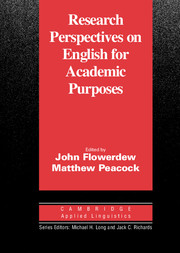Book contents
- Frontmatter
- Contents
- List of contributors
- Series editors' preface
- Preface
- I ISSUES IN ENGLISH FOR ACADEMIC PURPOSES
- Introduction to Part I
- 1 Issues in EAP: A preliminary perspective
- 2 Language use, language planning and EAP
- 3 EAP-related linguistic research: An intellectual history
- 4 Linguistic research and EAP pedagogy
- 5 International scientific English: The language of research scientists around the world
- 6 Discipline specificity and EAP
- 7 World Englishes: Issues in and from academic writing assessment
- 8 Addressing issues of power and difference in ESL academic writing
- 9 ‘I'll go with the group’: Rethinking ‘discourse community’ in EAP
- 10 EAP assessment: Issues, models, and outcomes
- II THE ENGLISH FOR ACADEMIC PURPOSES CURRICULUM
- References
- Index
2 - Language use, language planning and EAP
Published online by Cambridge University Press: 05 October 2012
- Frontmatter
- Contents
- List of contributors
- Series editors' preface
- Preface
- I ISSUES IN ENGLISH FOR ACADEMIC PURPOSES
- Introduction to Part I
- 1 Issues in EAP: A preliminary perspective
- 2 Language use, language planning and EAP
- 3 EAP-related linguistic research: An intellectual history
- 4 Linguistic research and EAP pedagogy
- 5 International scientific English: The language of research scientists around the world
- 6 Discipline specificity and EAP
- 7 World Englishes: Issues in and from academic writing assessment
- 8 Addressing issues of power and difference in ESL academic writing
- 9 ‘I'll go with the group’: Rethinking ‘discourse community’ in EAP
- 10 EAP assessment: Issues, models, and outcomes
- II THE ENGLISH FOR ACADEMIC PURPOSES CURRICULUM
- References
- Index
Summary
Introduction
In this article I will be looking at the current situation regarding the spread of English as an international language, the relationship of English with other languages, the attempt at intervention through language policy or language planning, and some of the implications of both the situation of language spread and of policy/planning for the practice of English for Academic Purposes or EAP.
I shall restrict the meaning of EAP to cover those educational activities in higher education, the purpose of which is the teaching and learning of the English language required by undergraduates, post-graduates and/or staff. Their subject of study is not the English language, which is a ‘carrier’ subject. They need English language and communication skills for access to subject knowledge or ‘content’, either, in the case of undergraduates and post-graduates, prior to their studies (‘pre-sessional’) or during them (‘in-sessional’). Such ‘content’ skills will cover the whole range of higher education curricula, in the sciences, humanities and social sciences.
I shall not be dealing with issues arising in EAP contexts at school level, interesting and important though this area is. I do not deal with language across the curriculum in bilingual education, for example, an area which is arguably a form of EAP. This activity is expanding as command of at least two languages, typically a first language and English as a working second language, is beginning to be perceived important and, by some, an expected part of social competence, particularly for those who can afford private education or who are dissatisfied with state provision (Brewster, 1999; Clegg, 1999).
- Type
- Chapter
- Information
- Research Perspectives on English for Academic Purposes , pp. 25 - 41Publisher: Cambridge University PressPrint publication year: 2001
- 7
- Cited by

